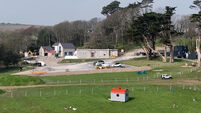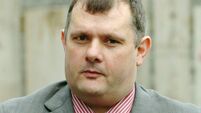The State must buy High Island. It’s a small price to pay for our heritage

The State paid €2m for a majority stake-holding in the Great Blasket a decade ago, which then-environment minister, John Gormley, considered good value, given the island’s cultural importance and its potential as a tourist attraction.
By contrast, High Island, off the Connemara coast, is for sale outright for €1.25m, but Environment Minister, Josepha Madigan, has ruled out the State buying it. She said:
There is no exceptional case, in this instance, that would merit an acquisition of this nature.
There are many calls on the minister’s money: 1,000 heritage sites are in State care, while 120,000 listed monuments are not.
But is High Island really “no exceptional case”? Or is it not exceptional in every way and of even more significance, in heritage terms, than the Great Blasket?
What is so special about those 80 acres 3.5km off the Co. Galway coast, near Claddaghduff?
Where to begin? The island hosts the remains of a major monastery that was in use, to differing degrees, from the 5th century to the 16th.
When the first in a series of seven seasons of excavations was begun, in 1995, it was discovered that the monastic structures had remained “largely untouched since late medieval times,” to quote Georgina Scally in High Island (Ardoileán), Co Galway: Excavation of an Early Medieval Monastery (2014).
For the casual visitor, such as myself, this translates into finding yourself standing on the brow of a hill, looking down at a monastic settlement, including a church, an intact beehive hut, and a water mill beside a lake.
You are a medieval monk. Or you expect a medieval monk to appear.
High Island is one of those rare archaeological sites that is both so isolated and so well-preserved that it allows you to step back in time. The monastic structures are amazing. The water mill, which fed the High Island monks, is the earliest of its type in Europe.
This sophistication is not surprising: High Island’s monastery once hosted a holy man called Gormgal, described in 1018, the year he died, as ‘Chief Anamcahara of Ireland.’
‘Anamchara’ means ‘soul friend’ or ‘confessor,’ but may have indicated a specific monastic function by the 11th century.
Gormgal, associated by some with Brian Boru, may have been considered the holiest man in Ireland at the time.
The image of a man standing in a boat carved on a footstone, at the east end of the church, is fascinating, in that the currach carrying the seeker towards an earthly paradise was a common motif in Irish pagan folklore, which was transferred to the Christian tradition.
St Brendan and St Colomba were pictured as such Christian travellers from faraway places, an image that may have also referenced St Peter, as the fisher of souls, and also Christ himself.
Archaeologist Christine Madden raises the possibility that the body buried at the footstone is that of Gormgal.
If this were the case, it is not surprising that High Island became a major place of pilgrimage until at least the 13th century.

The island has always been inaccessible, with two landing places (for differing sea conditions), both requiring pilgrims to scramble up a rock.
But pilgrims clearly made it out in numbers, as the settlement includes a porter’s lodge and a guest house.
Is the island’s inaccessibility really enough reason to leave it on the open market, in the hope that the person who buys it is as responsible as its current owner has been? Of course, the monuments are protected by law and planning permission would be required for any new structures.
However, the estate agent is suggesting permission might be secured for a “unique home” and a helipad. It is his job to maximise his client’s price and €1.25m is too high.
The fact remains, however, that if we do not enter negotiations to buy High Island, we will not be able to choose the buyer and we will have little control over what happens out there.
The island’s remoteness both protects it and leaves it vulnerable. On July 14 last, visitors who had accessed the island accidentally started a fire that burned through 10% of the land.
The monastery didn’t suffer, but the island’s equally important wildlife has no doubt been severely impacted. What this means is that the Storm Petrel eggs and chicks, which, almost uniquely on High Island, are laid in burrows in the tussocky grass, must have been incinerated if they were on the fire’s path.
The fact that Storm Petrels burrow in the grass, rather than just in the earth on High Island, was itself “a really exciting discovery,” in the words of UCC Zoology professor, John Quinn, who ran a major research project on the island in recent years.
The island is particularly well known for Storm Petrels and their larger, more astonishing burrowing relations, Manx Shearwaters, which are related to the Albatross and crawl on their bellies rather than walk.
It is because the island is uninhabited and has no rodents, let alone mammalian predators, that burrowing birds do so well there.
The UCC research used new recording techniques and found nearly 4,000 Petrels on the island, as well as 818 Shearwaters, a massive increase on previous estimates.
The island’s eco-system is so precious that Professor Quinn says he would love the State to buy it.
The poet Richard Murphy, who owned the island between 1969 and 1998, wrote movingly of being among thousands of Storm Petrels exiting their burrows to forage in darkness, when he spent the night alone in the ruined church:
Not lonely here, I have the company of thousands of birds rearing their young… a life I never knew existed… as if there were a resurrection of souls in a paradise of birds.
Murphy was attracted by the romance of the remote island, where monks had written in a scriptorium and where a stone slab bore the image of a holy man with two books in his hands, but he saw himself as custodian, not owner: “High Island can never be possessed,” he wrote, “because it will always remain the possession of the sea.”
It is up to us, now, to make sure High Island is neither possessed nor destroyed.
We have, in the internet, a tool of which the monks didn’t dream. With sophisticated weather modelling and a good website, we could make trips to the island possible for Irish citizens, as well as tourists, who would be prepared to watch, wait, and then pay.
Meanwhile, the knowledge that the oratory of Ireland’s Anamchara lay just off the coast would inspire a large wave of more mindful tourism in north Connemara, because, as Murphy wrote of his island, “Its virtue will have grown from its contemplation, not its use, from feelings and ideas evoked by its wild life and its end-of-the-world terrain.”












